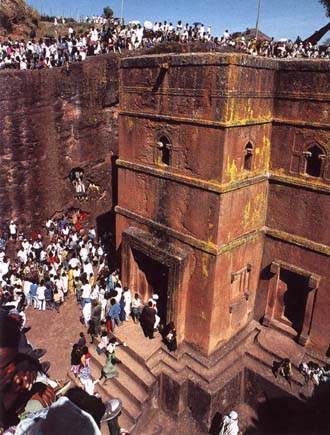|
|
|
Bahar Dar
The well-known lakeshore capital of the region,is situated 563 Kms from Addis Ababa, at the southern most end of Lake Tana, first rose to importance in the 16th century and is now an important trading center and tourist town for lake visitors. Popular sights are tankwas, the famous papyrus canoes that are used by the local Woyto people. The town is also the main departure point for visits to the islands of the lake.
The wide tree lined avenues of the create a resort atmosphere for this busy commercial center.It's also pleasant to walk west from the town center for about 500m past the Ghion Hotel then to follow a footpath to the lake shore, where there is a fish market, a great many papyrus tankwa boats, and often a large number of pelicans. Visitors can also visit the palace of Haile Selassie just outside the town. Barhar Dar is served by daily flights from Addis Ababa.
Debre TaborThe historic town of Debre Tabor, used to be the capital of Ras Gugsa Mersa and his sons and grandson. In 1860 Emperor Tewodros II also made it his Capital. The ruins of the old palace, and the church of Debre Tabor make for an interesting excursion.
| Gondar was Ethiopia's capital and principal city during the reign
of Emperor Fasilidas in the 17th century (1632-1667).He was responsible for the building
of a number of castle-like palaces together with the surrounding centuries-old churches
which depict sophisticated architectural wonders to be found there.
The oldest and the most impressive of Gondar's imperial structures is the two-storeyed palace of Emperor Fasilidas, which is built of roughly hewn brown basalt stones held together with mortar.Among the treasures of Gondar, The stone bathhouse of Emperor Fasiladas and the ruined Palace of Kusquam, The church of Debre Brhan Selassie, are few and subject to a gaze in awe at their unique murals, which have stood the test of time for centuries. |

|
The city retained its pre-eminence until the middle of the nineteenth century, when Emperor Tewodros II moved his seat of government to Debre Tabor and later to Mekdela. As a result, Gondar declined in importance ans was subsequently looted in the 1880s by the Sudanese Dervishes. By the early nineteenth century the city was a mere shadow of its former self. More recently, several hisoric buildings were damaged by British bombing during the Ethiopian liberation campaign of 1941. Most of Gondar's famous castles and other imperial buildings nevertheless have survived the ravages of time and together constitute one of Ethiopia's most fascinating antiquties.
Gondar, besides a rich historical background, has some of the best scenaries among the regions in Ethiopia.The ridge peaks of the Semien group of mountains in the North East & the deep valleys of Tekeze gorge and its tributaries.
| Rock-hewn churches of Lalibela are one of the famous treasures as a source of
tourist attractions in the region and for the country as a nation.They are found in Amhara Regional
state ( Southern Wollo),642 kilometres(398 miles) from Addis Ababa.They were built by one of the
influentcial king of the Zagwe dynasty in Ethiopia after the decline of Axumite kingdom.
The UNESCO has named the rock-hewn churches of Lalibela as the 8th wonders of the world.
The region's religious tradition is the typical manifestation of the major part of Ethiopian culture in the day-to-day lifestyle of the people, and nowhere does this spiritual energy echo more than in the monolithic churches of Lalibela. All 13 structures were carved from individual monolitic rocks in the 11th century, and are still open to the local people for religious ceremonies with their astonishing architectural designs and interior decorations.A historical myth narrates King Lalibela; on his own (with the help of angels) completed the construction of the churches.After his death the king has been designated as an Ethiopian saint. |
 |
The Jordan River divides the houses of worship that Lalibela built. The churches to the left symbolize earthly Jerusalem, while the churches on the right side of the river symbolize heavenly Jerusalem. The river itself is meant to symbolize the baptism of Christ. A complex maze of tunnels with crypts, grottoes and galleries connect the churches on either side of the Jordan River.
Transportation to Lalibela is served by road and by air on daily flights of Ethiopian Airlines. Always a place of unparalleled fascination, Lalibela is particulary interesting during religious celebrations, notably those of Ethiopia's Christmas (7 January), Timkat (19 January), and Easter, when Christians pour into the area from far and near.

